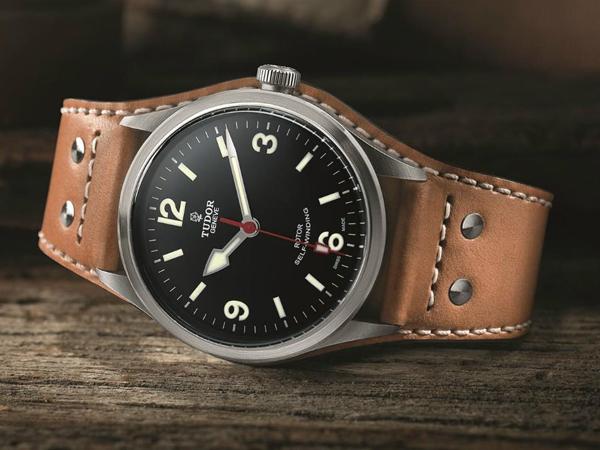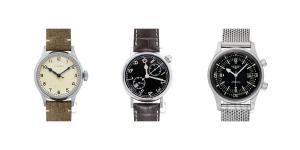Tudor Ranger: An In-Depth Review of the Vintage Field Watch

People often overlook the Tudor Ranger and its qualities. Tudor, being the little brother of Rolex, easily garnered attention among the collecting and professional circle. You may be more familiar with the Tudor Heritage Chronograph or the Tudor Black Bay. Both watches have endured their times being number one, not only for the brand but for their respective categories in general. These are amazing watches themselves, but there’s something about the humble Tudor Ranger that makes it a true classic.
No, you won’t find any record-breaking or historic moment anchored with it. No deep seas, high mountains, or never-travelled-before routes, but it surely has its merits. The Tudor Ranger is more than just a tool watch. It’s an everyday piece with an appeal and aesthetic that not all watches can carry. We all know how some watches simply like to serve a certain purpose. For instance, the Rolex Submariner functions mainly as a dive watch. You may not find the same features from such a powerful and expensive watch, but its simplicity is what people vie for in the Tudor Ranger.
Tudor Ranger: At a Glance
If you’re an experienced collector, a quick look at the Tudor Ranger will give you the Rolex Explorer vibe. Don’t dismiss it as it’s mostly compared to the timepiece. This is due to the fact that the Ranger and the Explorer are almost the same age. It’s most likely that the Ranger launched in response to the Explorer. Just like the Explorer, the Ranger features a black dial with Arabic numerals for the 3, 6, and 9 o’clock positions. Many people refer to this as the “Explorer Dial.” The vintage Ranger, however, measures 2mm short of the vintage Explorer.
While the vintage Explorer focused mainly on time, Tudor produced date iterations of the Ranger. Not to mention, the vintage Explorer only had one reference throughout its production; the Ranger has a few. As expected, these references have variations from each other, no matter how small they may be. Generally, the Ranger features the usual stainless steel case. It went into production from the late 1960s through the 1980s.
The New Tudor Heritage Ranger
Come 2014, Tudor launched the Tudor Heritage Ranger at BaselWorld. It came as a surprise for many people. It doesn’t have any innovative features. In fact, it’s the most honest iteration of a vintage one can find in the 21st century. Collectors especially had positive reviews of the watch. The watch doesn’t have any unnecessary feats like a ceramic bezel, sapphire casebacks, or even an added complication. It’s as if Tudor really meant to bring an old timepiece back to life, period.
Today, we’ll take a look at the 2014 Tudor Ranger and what makes it special. But to understand the great thing about the Ranger, we must first get deep into the history of the Tudor Oyster.
History of the Tudor Ranger
While the origin of the Tudor Ranger is no secret, it’s not a parade either. Tudor has been keeping it low when it comes to this watch. Perhaps, this is how the Ranger’s “most faked vintage watch” title comes from. A lot of people can be dismissive of certain Ranger references, while others can be fooled by faked ones. This is because there isn’t a lot going on about this watch. Not even Tudor themselves provide a comprehensive guide on this watch.
Tudor Oyster or Ranger?
The challenge with the Tudor Oyster relies on the fact that it’s not necessarily a reference of its own. Assembled right in Geneva, the Ranger isn’t much of an identity in itself when it first launched but an iteration of a Tudor Oyster. People would always refer to the number in between the lugs of the watch’s case where Rolex and Tudor would typically place it at. Collectors would often refer to this as one of the indicators of a watch’s heritage and even authenticity. However, the serial and reference number of the Ranger isn’t as clear as others would assume. It doesn’t have a unique reference number for its case. In fact, in the 1960s and 1970s, The Ranger comes in the same case as the Tudor Oyster, Oyster Prince, and Oysterdate. Therefore, it possesses similar reference case numbers to the aforementioned Tudor watches.
So, what exactly is a Tudor Ranger? It’s easiest to describe the watch as a 34mm Tudor Oyster. It also has a matte black dial and an “Explorer dial” with Arabic numerals at the 3, 6, 9, and 12 o’clock mark. Its hands also come in a distinguishable shovel hour hand. Now, the rest of the watch feels like an amalgamation of everything great about watchmaking at the time of its launch. It features an ETA calibre with a crown signed with the Rolex insignia, available with an Oyster bracelet. Still with us?
Tudor Ranger References

There are two timelines to the Tudor Ranger that could be of great help when determining a vintage’s originality. The Ranger divides into two series, namely “Early Series” and “Late Series”. The former are Rangers that share the references with Tudor Oysters and Oyster-Princes, starting with 79XX. Early Series Ranger was in production from the 1960s to the 1970s. The Late Series, on the other hand, launched in the 1980s. These Rangers have reference numbers of their own at the time, numbered from 90000.
Early Series Tudor RangersThe Early Series Tudor Rangers come in either Oyster Prince, Oyster, and Prince Oysterdate watches. The following references are specifically tagged as Rangers as well:
- Tudor Oyster, ref. 7984 and 7991
- Tudor Oyster Prince, ref. 7965 and 7995
- Tudor Prince Oysterdate, ref. 7966, 7996, 9050
The difference between the Oyster, the Oyster Prince, and the Prince Oysterdate isn’t too hard to understand either. The Oyster comes with a manual calibre. The Oyster Prince, on the other hand, comes with an automatic, time-only calibre. The Prince Oysterdate, as its name suggests, comes with a date complication along with the self-winding calibre.
Late Series Tudor RangersTudor Rangers from the Late Series still remain as rare as the Early Series ones. Generally, they still look the same but with their own cases, separate from the Tudor Oysters. The 90000 series Rangers still come at 34mm with the same Explorer dial. An ETA movement remains at the heart of the Ranger as well.
While the watch’s crown still has the Rolex insignia on it, the clasp of its Oyster-style bracelet comes with Tudor’s logo. Among the watch’s known reference are the following:
- Tudor Ranger, ref. 90020, a manual time-only reference with “Oyster” inscribed on the dial
- Tudor Ranger, ref. 90200, an automatic time-only reference with “Oyster Prince” inscribed on the dial
- Tudor Ranger, ref. 90220, an automatic time-only reference with “Oyster Prince” inscribed on the dial. This watch launched as a replacement to the 90200 on Tudor’s catalogue.
Up until 1988, the Late Series Tudor Ranger was in production. It took Tudor almost three decades for the brand to launch the timepiece anew.
The 2014 Tudor Ranger
At the 2014 BaselWorld, Tudor introduced the new Tudor Ranger. The inspiration for this new Tudor Ranger is the Tudor Oyster Prince Ref. 7995. This automatic, time-only reference comes with the same black dial and was in production from 1966 to 1969.
Some of the Reference 7995 comes with a rose logo on top of the “Tudor” brand inscription on the dial. The others also feature the shield logo, a time when Tudor was in transition between logos. The watch’s self-winding rotor comes with an engraved “Tudor Auto-Prince”, the movement number, and the numbers “2484” under the balance wheel.
With this in mind, the 2014 Tudor Ranger launches. With its size and simplicity, it’s marketed as a field watch with an even more balanced and readable dial. With that said, let’s get on the watch’s features and what makes it special.
Case Design

Compared to Reference 7995, the new Ranger increased its size to 41mm, still with a stainless steel case. It also comes with a domed sapphire crystal that protects its dial. Overall, the thickness of the watch equates to 12.2 mm with a weight of 85g on a fabric strap.
It’s also easy to replace the strap of the Ranger given its 22mm lug width. You can change into any type of strap such as leather and steel with the drilled lugs supported by four factory available mounts. Lug-to-lug, it measures at 48mm which only works just right given its case size.
Essentially, the Ranger is a more affordable explorer. Rolex created Tudor with the intent to provide more affordable watches for its market. They do this by using a third-party movement instead of an in-house calibre. The same applies to the Ranger having a Rolex case and an ETA 2824 movement. Its case functions the same as a Rolex case with a satin finish as well as sharp edges.
Having a screw-down crown, the Tudor Ranger comes with a 150m depth rating. However, many Tudor and Rolex enthusiasts don’t like the way the crown sits 1mm from the edge of the case. This provides space to see an exposed part of the crown tube. But generally, it’s a reliable crown that doesn’t wobble and comes with a good grip.
Since the watch comes at 41mm, many people like to take it for a dive. Given the watch’s depth rating, it’s not so impossible as well. The wide field of view on this watch makes it just as legible underwater as it is on land. However, it doesn’t come with any bezel. Despite that, Tudor made sure to give the Ranger a wide margin to encase the dial and support it properly.
Dial

The appeal of the Ranger’s dial design rests on the fact that it’s a no-nonsense legible dial. The absence of the date window gives the dial more space to breathe. It directly takes from Reference 7995 for that matter. But given the bigger dial design, it’s more balanced and perfectly readable at all times. There are no other ornamentations and it doesn’t even come with a showy font. The Arabic numbers at 3, 6, 9, and 12 o’clock are written in sans-serif for the perfect military gear watch appeal. It also comes with a warm faux-aged lume on the hands and markers that last for a long time.
The hands of the watch fit just right with the huge dial space that doesn’t overwhelm. The Rolex Explorer suffers from this very problem, given that its minute hand falls a bit too short for people’s preference. Moreover, the matte dial absorbs all light reflecting from the domed sapphire crystal. This could be of great help especially when dealing with too much light such as during the day.
Movement
The ETA 2824 movement is one of the workhorse calibres from ETA. In general, ETA movements provide a reliable heart for any timepiece at a relatively affordable price compared to in-house movements. With 28,800 beats per hour, the ETA 2824 is a high-frequency movement that provides better accuracy for the timepiece. You can get about 38 hours of power reserve with this watch. It’s the same movement you can find on a classic Tudor Black Bay watch.
Straps

The Tudor Heritage Ranger may come with a few options for straps. Firstly, we have the leather strap (Tudor Ranger Ref. 79910-0013) that is soft to the touch and perfect for everyday use. Next, the fabric strap would be friendlier if you do decide to take your Ranger for a spin on outdoor activities. You may also opt for a leather bund strap (Tudor Ranger Ref. 79910-BKBR or Tudor Ranger Ref. 79910-0012) that would be perfect for optimum protection for a trip all day in the sun. It, after all, functions mainly as a field watch. The steel bracelet (Tudor Ranger Ref. 79910-0001) also makes a good case for daily wear or even a short swim.
Final Thoughts
The general consensus for this watch is that it’s a reliable timepiece without the hullabaloos you’d expect from a brand related to Rolex. Essentially, Tudor and Rolex provide the same excellence when it comes to timepieces. But what we didn’t expect with the Tudor Ranger is that it goes on to provide accuracy and simplicity without having to sacrifice its character. It’s hard to disagree with the people claiming that this could be the best vintage timepiece a brand has to offer yet. It is truly faithful to its inspiration and it didn’t even take a second try to get it right.
Perhaps, Tudor has been preparing all those 26 years to create a Ranger that not only has its own spirit but also continues to prove that it’s a classic. While there still isn’t any new news about another Tudor Ranger in our midst, we can only hope to see more from it, perhaps a stand-alone collection of its own.
Can’t get enough of Tudor? Check out our review of the Tudor GMT and our guide to the Tudor Pelagos vs. Rolex Submariner.
All photos courtesy of Tudor Watches


